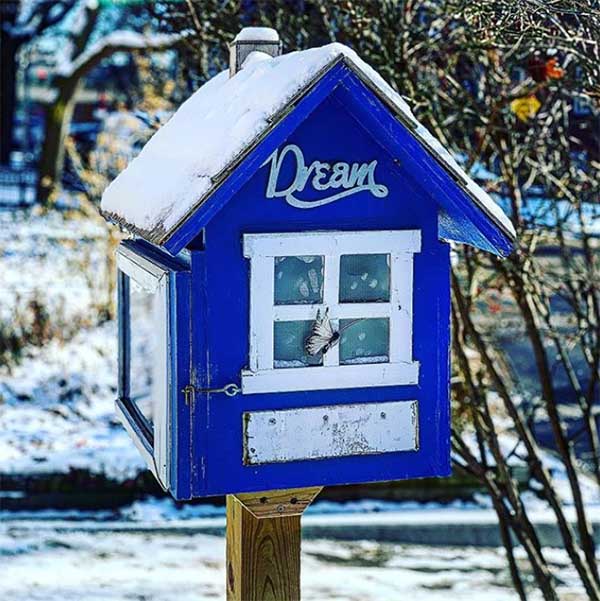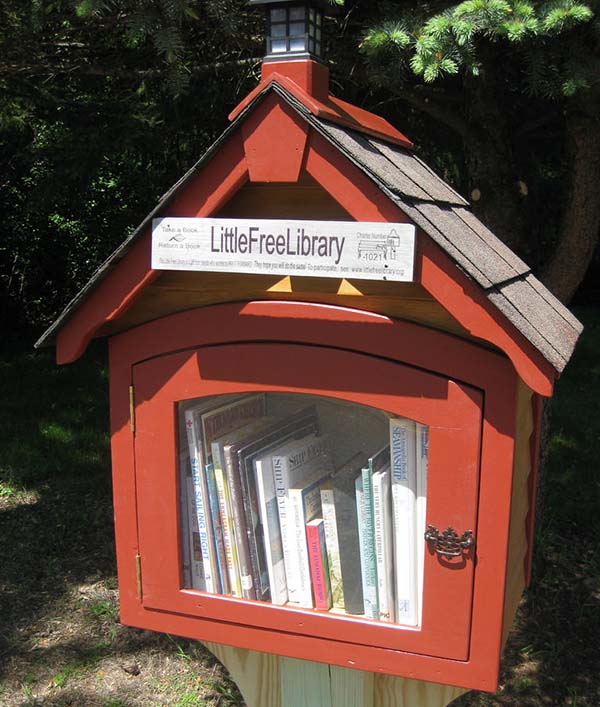Can your Little Free Library withstand the winter? If you’ve been wondering how to winterize your library, or whether you should take it down until the weather warms up, read on! We’ll answer common questions about library maintenance during the snowy season.
Should you take your Library down for the winter?
There are two big factors to consider. First, can your book-sharing box keep out moisture? Little Free Libraries purchased from our online store are designed to keep out rain and snow. If you built your own library, then we recommend testing whether it’s waterproof. You can do this by removing everything from inside your library. Then, spray it down with a hose from the outside and check to see if water seeped in anywhere. If it did, then your library isn’t weatherproof, and you may want to move it inside for the winter.
Obviously you can’t do this test in the middle of winter. (Unless you’re trying to encase your library in a sheet of ice.) But you may not need to. If you notice snow or water inside, get the books out of there. A quick fix would be caulking the seams of your library with silicone caulk. Or you could put up a “Closed until spring!” sign and deal with it when the weather warms up.
The second factor to consider is whether people will be able to reach your library when it snows. If your library is close to a road, will it get buried when snowplows go by? If so, you’ll either have to regularly shovel it out or consider moving it or shutting it down for the winter. If your library isn’t near a well-maintained sidewalk or path, are people going to trudge through several feet of snow to get to it? A few people might. But most people won’t. It’s up to you to decide whether “closing” your library until the spring makes sense for your situation.

How can you protect your library from snow and water?
If your Little Free Library is made of wood, then ice and snow can damage it. Wood that is regularly exposed to moisture may mold, rot, or grow mildew. The key is to coat your Library with a paint or stain that will protect it. Little Free Library steward Keith Wilson knows all about good construction. Keith is a mechanical engineer and an avid woodworker; he’s built boats as well as several Little Free Libraries.
Keith recommends using a standard house paint on your library to weatherproof it. A good exterior house paint is durable, inexpensive, and universally available. He also always uses primer, which is designed to bond well to wood, but it’s not weather resistant. That’s why he follows the primer with several coats of paint.
“Clear finishes are always less durable than pigmented ones. I recommend against messing with varnish or stain at all, and just painting everything. There seems to be an idea out there that paint needs to be ‘sealed’ with polyurethane varnish, but that’s silly,” Keith said. “The paint’s more durable than the varnish. Most varnishes are very vulnerable to UV light, and are far better indoors. If you must use varnish, buy the best marine finish you can afford (it has more UV-absorbing ingredients). Put on lots and lots of coats. Those lovely varnished mahogany powerboats usually have a dozen coats of varnish, hand-sanded between coats. It still won’t last as long as ordinary house paint.”
Other than paint, what should you do to winterize your library?
There are a few more tricks to keeping your library in good shape through the winter. First, a flat roof will collect snow. When the snow melts, water will puddle on top of your library and wear down the wood. A slanted roof that sheds snow is best. If your library has a flat roof, regularly clear off the snow.

Second, a roof overhang will keep rain and snow away from the door and sides of your library. You don’t want water to run off the roof and directly down over the door and sides. When the door opens, water will get inside. We recommend a roof overhang of at least 3″.
Third, elevate the books inside your library by placing a silicone mat inside. The goal is twofold. You want the books to be slightly elevated off the floor so that if water does get inside, the books don’t sit directly in it. Elevating the books also allows air to flow beneath them. Better air circulation means less condensation.
We hope you’re ready to winterize your Library! Get more library repair and maintenance tips, or learn how to start your own Little Free Library!

